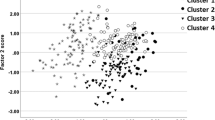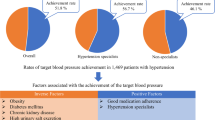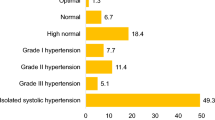Abstract
Unsatisfactory blood pressure (BP) control so often described in treated hypertensive populations is also explained by insufficient physicians' awareness of experts' guidelines. We assessed awareness of current recommendations about hypertension management in a general practice setting, using the World Health Organization/International Society of Hypertension (WHO/ISH) 1999 guidelines as reference. In a regionwide survey, a total of 5133 physicians (three-quarters of all active general practitioners in Lombardy, a region of north-western Italy) were contacted by letter and received a multiple choice 10-item questionnaire. Data on physicians' demographic characteristics, information on hypertension prevalence and their perception of BP control among their patients were also requested in an additional form. The number of answers in agreement with WHO/ISH guidelines was used as an awareness measure. This was considered adequate if correct answers to six out of 10 questions, including an appropriate definition of hypertension, were provided. Of the 1256 returned questionnaires (a 24.5% response rate), 1162 were suitable for analysis. The mean score of correct answers was 5.3 points and only 20.1% of the study population correctly answered at least six of the questions (including that on the definition of hypertension in the elderly). Guidelines awareness was negatively related to increase in physicians' age and duration of clinical practice and by the male gender. Finally, the physicians reported a high rate of achieved BP control, and those who were considered to have achieved highest rates (>75%) of control in their patients had a lower rate of adequate knowledge than those who reported less-successful therapeutic results (18 vs 25%, P<0.01), suggesting that they ignored or disregarded the goal BP recommended by the guidelines. This large regional survey shows that a sufficient degree of guidelines awareness is present in a minority of primary-care physicians in the Italian region of Lombardy. Therefore, further efforts are required to intensify information strategies for improving professional education, training and practice organization aimed at achieving therapeutic goals. Physicians with longer duration of clinical practice represent a particularly relevant target group for these interventions.
This is a preview of subscription content, access via your institution
Access options
Subscribe to this journal
Receive 12 digital issues and online access to articles
$119.00 per year
only $9.92 per issue
Buy this article
- Purchase on Springer Link
- Instant access to full article PDF
Prices may be subject to local taxes which are calculated during checkout


Similar content being viewed by others
References
Joint National Committee on Prevention, Detection, Evaluation and Treatment of High Blood Pressure. The Sixth Report of the Joint National Committee on Prevention, Detection, Evaluation and Treatment of High Blood Pressure. Arch Intern Med 1997; 157: 2413–2446.
Guidelines Subcommittee. 1999 World Health Organization/International Society of Hypertension Guidelines for the management of hypertension. J Hypertens 1999; 17: 151–183.
Marques-Vidal P, Tuomilelto J . Hypertension awareness, treatment and control in the community: is the rule of halves still valid? J Hum Hypertens 1997; 11: 213–220.
Burt VL et al. Trends in the prevalence, awareness, treatment and control of the hypertension in the adult US population. Data from the heath examination surveys 1960–1991. Hypertension 1995; 26: 60–65.
Primatesta P, Brookers M, Poulter NR . Improved hypertension management and control. Results from the health survey for England 1998. Hypertension 2001; 38: 827–832.
Chamontin B et al. Prevalence, treatment and control of hypertension in the French population. Data from a survey on high blood pressure in general practice. Am J Hypertens 1998; 11: 759–762.
Fagard RH, Van der Enden, Leeman M, Warling X . Survey on treatment of hypertension and implementation of WHO/ISH risk stratification in primary care in Belgium. J Hypertens 2002; 20: 1297–1302.
EUROASPIRE Study Group. EUROASPIRE. A European Society of Cardiology survey of secondary prevention of coronary heart disease: principal results. Eur Heart J 1997; 18: 1569–1582.
Lifestyle and risk factor management and use of drug therapies in coronary patients from 15 countries; principal results from EUROASPIRE II Euro Heart Survey Programme. Eur Heart J 2001; 7: 554–572.
Cuspidi C et al. High prevalence of cardiac and extracardiac target organ damage in refractory hypertension. J Hypertens 2001; 19: 2063–2070.
Samuelsson O et al. Predictors of cardiovascular morbidity in treated hypertension: results from the primary preventive trial in Goteborg, Sweden. J Hypertens 1985; 3: 167–176.
Burnier M . Blood pressure control and the implementation of guidelines in clinical practice: can we fill the gap? J Hypertens 2002; 20: 1251–1253.
Cuspidi C et al. Awareness of hypertension guidelines in general practice: a pilot study in Lombardy. Ital Heart J 2002; 3: 60–63.
Dillman DA . The total design method. In: Dillman DA (ed). Mail and Telephone Surveys. Wiley: New York, NY, 1978, pp 22–26.
Hagemeister J et al. Hypertension guidelines and their limitations, the impact of physicians' compliance as evaluated by guidelines awareness. J Hypertens 2001; 19: 2079–2086.
Menotti A et al. On behalf of the Gubbio Study Research Group. Impact of the Gubbio population study on community control of blood pressure and hypertension. J Hypertens 2001; 19: 843–850.
Colhoun HM, Dong W, Poulter NR . Blood pressure screening, management and control in England: results from the health survey for England 1994. J Hypertens 1998; 16: 747–752.
Burt VL et al. Prevalence of hypertension in the US adult population. Results from the third National Health and Nutrition Examination Survey, 1988–1991. Hypertension 1995; 25: 305–315.
Phillips LS et al. Clinical inertia. Ann Intern Med 2000; 135: 825–834.
Asch DA, Jedrzievski MK, Christakis NA . Response rates to mail surveys published in medical journals. J Clin Epidemiol 1997; 50: 1129–1136.
Brodsky MA et al. Regional attitudes of generalists, specialists and subspecialists about management of atrial fibrillation. Arch Intern Med 1996; 156: 2553–2562.
Morganroth J, Bigger JT, Anderson JL . Treatment of ventricular arrhythmias by United States cardiologists. Am J Cardiol 1990; 65: 40–48.
Ayanian JZ et al. Knowledge and practices of generalist and specialist physicians regarding drug therapy for acute myocardial infarction. N Engl J Med 1994; 331: 1336–1342.
Friedmann PD, Brest AS, Mayo-Smith MF . Differences in generalits' and cardiologists' estimates of baseline cardiovascular risk outcomes of preventive therapy in cardiovascular disease. Ann Intern Med 1996; 124: 414–421.
Ambrosioni E et al. Patterns of hypertension management in Italy results of a pharmacoepidemiological survey on antihypertensive therapy. J Hypertens 2000; 18: 1691–1699.
Hyman DJ, Pavlik VN . Self-reported hypertension treatment practices among primary care physicians. Arch Intern Med 2000; 160: 2281–2286.
Acknowledgements
The study was supported by an unrestricted scientific grant from Pfizer, Italia.
Author information
Authors and Affiliations
Consortia
Corresponding author
Rights and permissions
About this article
Cite this article
Cuspidi, C., Michev, I., Meani, S. et al. Awareness of hypertension guidelines in primary care: results of a regionwide survey in Italy. J Hum Hypertens 17, 541–547 (2003). https://doi.org/10.1038/sj.jhh.1001589
Received:
Accepted:
Published:
Issue Date:
DOI: https://doi.org/10.1038/sj.jhh.1001589
Keywords
This article is cited by
-
Hypertension management initiative prospective cohort study: comparison between immediate and delayed intervention groups
Journal of Human Hypertension (2014)
-
Blood Pressure Control in Italian Essential Hypertensives Treated by General Practitioners
American Journal of Hypertension (2012)
-
Practice and awareness of physicians regarding home blood pressure measurement in Japan
Hypertension Research (2010)
-
Major Cardiovascular Risk Factors Are Not Taken Into Account by Physicians When Targeting Blood Pressure Values for Uncontrolled Hypertensive Patients
American Journal of Hypertension (2008)
-
Aim, design and methods of the ‘reasons for not intensifying antihypertensive treatment’ (RIAT): an international registry in essential hypertension
Journal of Human Hypertension (2006)



